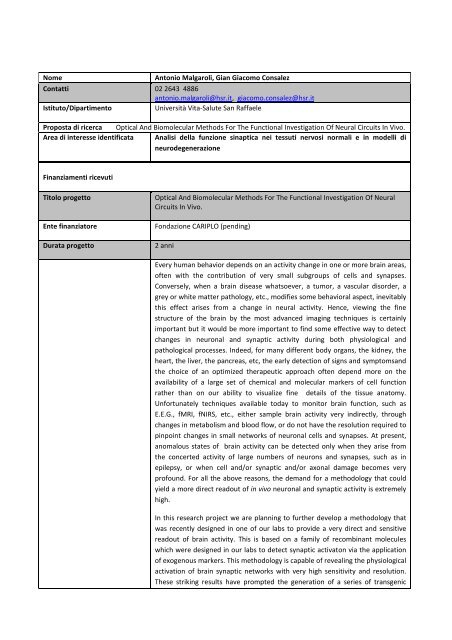Mapping of Italian research excellence in Neurodegenerative - Apre
Mapping of Italian research excellence in Neurodegenerative - Apre
Mapping of Italian research excellence in Neurodegenerative - Apre
You also want an ePaper? Increase the reach of your titles
YUMPU automatically turns print PDFs into web optimized ePapers that Google loves.
Nome Antonio Malgaroli, Gian Giacomo Consalez<br />
Contatti<br />
02 2643 4886<br />
antonio.malgaroli@hsr.it, giacomo.consalez@hsr.it<br />
Istituto/Dipartimento Università Vita-Salute San Raffaele<br />
Proposta di ricerca Optical And Biomolecular Methods For The Functional Investigation Of Neural Circuits In Vivo.<br />
Area di <strong>in</strong>teresse identificata Analisi della funzione s<strong>in</strong>aptica nei tessuti nervosi normali e <strong>in</strong> modelli di<br />
neurodegenerazione<br />
F<strong>in</strong>anziamenti ricevuti<br />
Titolo progetto<br />
Ente f<strong>in</strong>anziatore<br />
Durata progetto<br />
Optical And Biomolecular Methods For The Functional Investigation Of Neural<br />
Circuits In Vivo.<br />
Fondazione CARIPLO (pend<strong>in</strong>g)<br />
2 anni<br />
Every human behavior depends on an activity change <strong>in</strong> one or more bra<strong>in</strong> areas,<br />
<strong>of</strong>ten with the contribution <strong>of</strong> very small subgroups <strong>of</strong> cells and synapses.<br />
Conversely, when a bra<strong>in</strong> disease whatsoever, a tumor, a vascular disorder, a<br />
grey or white matter pathology, etc., modifies some behavioral aspect, <strong>in</strong>evitably<br />
this effect arises from a change <strong>in</strong> neural activity. Hence, view<strong>in</strong>g the f<strong>in</strong>e<br />
structure <strong>of</strong> the bra<strong>in</strong> by the most advanced imag<strong>in</strong>g techniques is certa<strong>in</strong>ly<br />
important but it would be more important to f<strong>in</strong>d some effective way to detect<br />
changes <strong>in</strong> neuronal and synaptic activity dur<strong>in</strong>g both physiological and<br />
pathological processes. Indeed, for many different body organs, the kidney, the<br />
heart, the liver, the pancreas, etc, the early detection <strong>of</strong> signs and symptomsand<br />
the choice <strong>of</strong> an optimized therapeutic approach <strong>of</strong>ten depend more on the<br />
availability <strong>of</strong> a large set <strong>of</strong> chemical and molecular markers <strong>of</strong> cell function<br />
rather than on our ability to visualize f<strong>in</strong>e details <strong>of</strong> the tissue anatomy.<br />
Unfortunately techniques available today to monitor bra<strong>in</strong> function, such as<br />
E.E.G., fMRI, fNIRS, etc., either sample bra<strong>in</strong> activity very <strong>in</strong>directly, through<br />
changes <strong>in</strong> metabolism and blood flow, or do not have the resolution required to<br />
p<strong>in</strong>po<strong>in</strong>t changes <strong>in</strong> small networks <strong>of</strong> neuronal cells and synapses. At present,<br />
anomalous states <strong>of</strong> bra<strong>in</strong> activity can be detected only when they arise from<br />
the concerted activity <strong>of</strong> large numbers <strong>of</strong> neurons and synapses, such as <strong>in</strong><br />
epilepsy, or when cell and/or synaptic and/or axonal damage becomes very<br />
pr<strong>of</strong>ound. For all the above reasons, the demand for a methodology that could<br />
yield a more direct readout <strong>of</strong> <strong>in</strong> vivo neuronal and synaptic activity is extremely<br />
high.<br />
In this <strong>research</strong> project we are plann<strong>in</strong>g to further develop a methodology that<br />
was recently designed <strong>in</strong> one <strong>of</strong> our labs to provide a very direct and sensitive<br />
readout <strong>of</strong> bra<strong>in</strong> activity. This is based on a family <strong>of</strong> recomb<strong>in</strong>ant molecules<br />
which were designed <strong>in</strong> our labs to detect synaptic activaton via the application<br />
<strong>of</strong> exogenous markers. This methodology is capable <strong>of</strong> reveal<strong>in</strong>g the physiological<br />
activation <strong>of</strong> bra<strong>in</strong> synaptic networks with very high sensitivity and resolution.<br />
These strik<strong>in</strong>g results have prompted the generation <strong>of</strong> a series <strong>of</strong> transgenic


